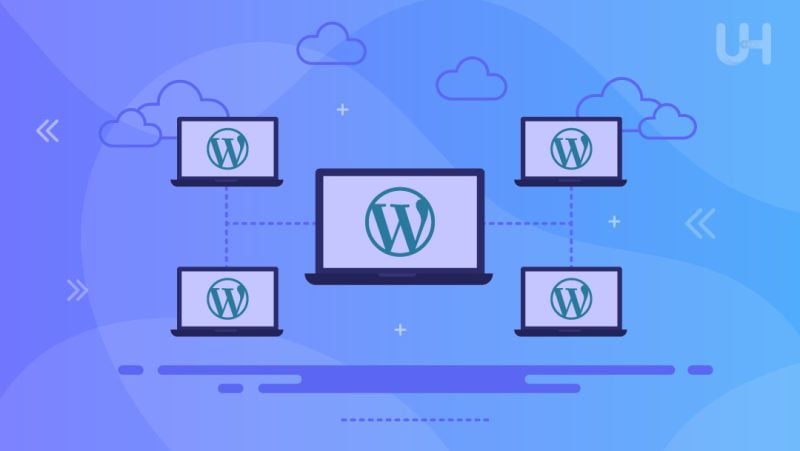WordPress is renowned as a leading CMS platform, empowering users to create stunning websites with ease. But as the need for managing multiple sites grows, WordPress Multisite emerges as a game-changer.
With Multisite, you can oversee multiple websites from a single WordPress installation. This centralized approach simplifies tasks like updates and user management, saving time and reducing errors. Plus, it offers scalability, allowing seamless integration of new sites into your network.
What is a WordPress Multisite?
WordPress Multisite is a feature that allows users to manage multiple websites from a single WordPress installation. In essence, it transforms a standalone WordPress site into a network of interconnected sites, all sharing the same WordPress core files, plugins, and themes.
Unlike traditional single WordPress installations, where each website operates independently, Multisite centralizes website management. This means that updates, installations, and maintenance tasks can be performed once and applied across the entire network, saving time and effort for administrators.
Comparing Multisite with single WordPress installations highlights the efficiency and scalability of the former. While single installations are suitable for managing individual websites, Multisite shines when there’s a need to oversee multiple sites with shared server resources and consistent management.
With Multisite, users can create new sites within the network effortlessly, each with its own unique domain name or subdomain. Moreover, this modular approach allows for easy expansion and organization of websites, making it ideal for businesses, educational institutions, and large-scale organizations with enterprise hosting.
Benefits of WordPress Multisite
WP Multisite offers a range of benefits that make it an attractive solution for managing multiple websites efficiently:
- Centralized Management: With Multisite, you can oversee all your websites from a single dashboard. This centralized approach simplifies tasks such as content management, plugin updates, and theme installations. Instead of logging into multiple sites individually, administrators can access and manage everything from one location, saving time and effort.
- Cost-Effectiveness: Hosting multiple sites under one WordPress installation can lead to significant cost savings. Instead of purchasing separate hosting plans for each site, you can host them all on the same server, reducing hosting expenses. This makes Multisite an economical choice for businesses looking for WordPress hosting for agencies and organizations looking to manage multiple websites within a budget.
- Streamlined Updates and Maintenance: One of the most significant advantages of Multisite is its ability to streamline updates and maintenance tasks across the entire network. When updates for WordPress core files, plugins, or themes are available, administrators can apply them to all sites in the network simultaneously. This ensures consistency and reduces the risk of security vulnerabilities or compatibility issues.
- Enhanced Control Over User Roles and Permissions: Multisite provides administrators with granular control over user roles and permissions across all sites in the network. From the Super Admin level, you can assign different roles to users, granting them specific capabilities based on their responsibilities. Moreover, this centralized user management ensures consistent access control policies and simplifies user administration tasks.
Optimize Your Website with WordPress Multisite!
Explore the power of WordPress Multisite and unlock efficient website management. Get started today with our WordPress hosting plans at Ultahost!
Managing Websites in WordPress Multisite
Managing websites in WordPress Multisite involves understanding the roles, responsibilities, and capabilities of the Super Admin, as well as efficiently creating and managing individual websites within the network, while also ensuring appropriate user roles and permissions are set.
Super Admin Role Overview
The Super Admin is the highest level of authority in a WordPress Multisite network. This role has access to all sites within the network and possesses capabilities that surpass those of regular site administrators. Super Admins have the power to install and activate themes and plugins network-wide, manage user accounts, create new WordPress websites, and oversee the overall functioning of the Multisite network.
Creating and Managing Individual Websites
Creating new websites within a Multisite network is a straightforward process for Super Admins. They can easily add new sites directly from the network admin dashboard, assigning a unique domain or subdomain to each site. Once created, Super Admins have the flexibility to customize settings, install themes and plugins, and manage content for each individual site.
User Roles and Permissions
WordPress Multisite offers a range of user roles, each with specific capabilities and permissions. Super Admins have the authority to assign roles to users across the entire network, granting appropriate access levels based on their responsibilities. Common user roles include Administrator, Editor, Author, Contributor, and Subscriber. Super Admins can also create custom roles with tailored permissions to meet specific requirements.
It’s crucial for Super Admins to carefully manage user roles and permissions to maintain security and control access to sensitive network resources. By assigning appropriate roles to users, Super Admins can ensure that each individual has the necessary level of access to perform their tasks effectively while safeguarding the integrity of the Multisite network.
Themes and Plugins in WordPress Multisite

When it comes to themes and plugins in WordPress Multisite, it’s essential to consider compatibility, management strategies, and recommended options tailored for Multisite environments.
Compatibility of Themes and Plugins
Before installing themes and plugins in a Multisite network, it’s crucial to ensure compatibility with Multisite functionality. While most themes and plugins are compatible with Multisite, some may require additional configuration or testing to function correctly across all sites in the network. Moreover, it’s recommended to check the developer’s documentation or reviews to confirm compatibility with Multisite before installation.
Managing Themes and Plugins Network-wide vs on Individual Sites
WordPress Multisite offers flexibility in managing themes and WordPress plugins, allowing administrators to choose between network-wide activation or activation on individual sites. Network-wide activation means that themes and plugins are activated for all sites in the network by default. This approach ensures consistency across the network and simplifies management tasks such as updates and maintenance. However, administrators can also activate themes and plugins individually on specific sites, allowing for customization and flexibility based on site requirements.
Recommended Themes and Plugins for WordPress Multisite
When selecting a WordPress theme and plugins for a Multisite network, it’s essential to choose options that are well-suited for managing multiple sites efficiently. Some themes and plugins are specifically designed with Multisite compatibility and features in mind, making them ideal choices for Multisite environments. Here are some recommended themes and plugins for WordPress Multisite:
Themes: Look for themes that offer robust customization options, responsive design, and compatibility with popular page builders. Some popular Multisite-friendly themes include Divi by Elegant Themes, Avada by ThemeFusion, and GeneratePress by Tom Usborne.
Plugins: Consider plugins that enhance Multisite functionality, streamline management tasks, and improve site performance. Essential Multisite plugins include Multisite Enhancements, which adds useful features to the network admin dashboard, and Pro Sites, which allows you to monetize your Multisite network by offering premium features to users.
Best Practices and Tips for WordPress Multisite
WordPress Multisite offers unparalleled convenience for managing multiple websites, but to ensure optimal performance, security, and scalability, it’s essential to follow best practices and implement effective strategies. Here are some tips to help you make the most of your Multisite installation:
Performance Optimization Techniques
- Utilize caching: Implement caching mechanisms such as WordPress caching plugins or server-level caching to improve website performance and reduce server load.
- Optimize images: Compress and optimize images to reduce file sizes and improve page load times across your network.
- Minimize plugins: Limit the number of plugins used in your Multisite network to reduce resource usage and potential conflicts. Choose lightweight and well-coded plugins for essential functionality.
- Utilize content delivery networks (CDNs): Distribute your website’s content across multiple servers globally to improve load times for users worldwide.
Security Considerations and Best Practices
- Keep WordPress core, themes, and plugins up to date: Regularly update WordPress core files, themes, and plugins to patch security vulnerabilities and protect your network from potential threats.
- Implement strong user authentication: Enforce strong password policies and consider implementing two-factor authentication (2FA) for added security.
- Limit user privileges: Assign appropriate user roles and permissions to ensure that users only have access to the resources they need. Moreover, restrict access to sensitive areas such as the network admin dashboard.
- Monitor and log activity: Use security plugins or server-level monitoring tools to track user activity and detect suspicious behavior or unauthorized access attempts.
Scaling and Growing Your Multisite Network Effectively
- Plan for scalability: Consider the future growth of your Multisite network when designing your infrastructure and selecting hosting providers. Choose scalable hosting solutions that can accommodate increased traffic and resource demands.
- Implement a content distribution strategy: As your network grows, consider implementing a content distribution strategy to distribute content across multiple servers or data centers for improved performance and reliability.
- Streamline site creation and management: Develop standardized processes and templates for creating and managing new sites within your network to streamline operations and maintain consistency.
- Regularly review and optimize: Periodically review your Multisite network’s performance, security, and scalability, and make necessary adjustments to ensure ongoing efficiency and effectiveness.
Conclusion
WordPress Multisite represents a powerful solution for managing multiple websites efficiently, offering centralized management, cost-effectiveness, and streamlined updates. By consolidating all websites under one installation, Multisite simplifies tasks for administrators, enhances control over user roles and permissions, and provides scalability for growing networks.
Ready to scale up your WordPress Multisite for even greater performance and flexibility? Dive into our specialized WordPress VPS hosting solutions at Ultahost. Elevate your website management experience today!
FAQ
Is WordPress Multisite suitable for all types of websites?
While WordPress Multisite is a versatile solution, it may not be suitable for every scenario. Multisite is well-suited for managing networks of related websites, such as corporate websites, educational platforms, or publishing networks.
Can I migrate existing WordPress sites to a Multisite network?
Yes, it’s possible to migrate existing WordPress sites to a Multisite network. However, the process can be complex and may require careful planning and execution to ensure a smooth transition. Moreover, it is recommended to create backups of your sites and consult with a developer or migration specialist for assistance.
How can I ensure security across my Multisite network?
To enhance security in a Multisite network, it’s essential to keep WordPress core, themes, and plugins up to date, enforce strong user authentication measures, limit user privileges, and monitor user activity.
What are some common challenges with WordPress Multisite?
Some common challenges with WordPress Multisite include compatibility issues with themes and plugins, managing updates across multiple sites, and maintaining performance and scalability as the network grows.








